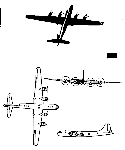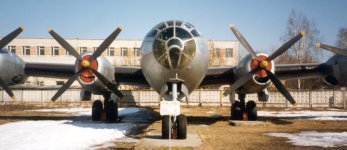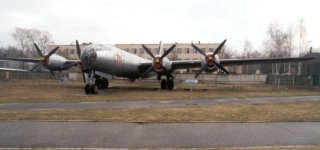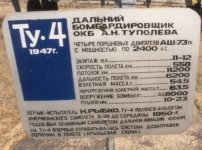





During World War II an arrangement of aerial maneuvers code-named FRANTIC comprised the largest and most complete military projects linking the United States of America and the Union of Soviet Socialist Republics as allies against Germany. This was the only direct combat cooperation between the American and Soviet war efforts. The United States Army Air Force conducted FRANTIC as an extension of the Combined Bomber Offensive (CBO) in Europe. The 8th and 15th Air Forces flew B-17 Flying Fortresses deep into central Europe to attack German war materiel and military bases, then continued east to land in the Ukraine. Soviet troops serviced and protected the Army Air Force units, which rearmed and flew of to hit more targets enroute to their home stations.
Work on a long range bomber, capable of striking at targets in deep enemy territory, began in the Soviet Union in 1943. Three American B-29 bombers flying against Japan had landed in Siberia and were seized by the Soviets. By August 1944 the the "64" design had been developed at OKB-156 under the direction of A.N. Tupolev, with similar characteristics. The maximum range of the Soviet bomber carrying a load of 4,000 kg was planned to be 6,500 km. However, in June 1945, after development began, the Soviet Union decided to drop the project "64" and build an exact copy of the B-29 bomber instead.
This Soviet copy of the B-29 was also built by OKB-156, under the designation B-4 or product "P". The project received the highest priority and was under direct control of the Politbureau, and was supposed to be completed within two years.
In mid 1945 the three American B-29 bombers were delivered to Moscow. One plane was transferred to the Flight-test institute in Zhukovski to train pilots for preparing flight training manuals, the second plane was disassambled to study its' design and the third was left as a yardstick. However, the Soviets decided not to attempto to copy the American engine, and instead equipped the bomber with the Soviet ASH-73TK engine designed by A.D. Shvetsov. This engine retained the B-29's original turbocompressor and the magnet and heat-resistant bearings. The Soviet bomber also carried improved gun turrets of Soviet design.
The Bull is a midwing, four-engine, medium bomber with two bomb bays centrally located in the fuselage, extending fore and aft of the wing. Defensive armament consists of four turrets located in upper forward, lower forward, lower rear, and tail positions.
The first B-4 bomber was finished in the spring of 1947 and carried out its' first flight on 19 May 1947. Flight tests continued through 1949. Full-scale production of the aircraft, under the designation Tu-4. began in 1947 at the plant Nr. 22 in Kazan and at plant Nr. 18 in Kuibyshev. In 1948, an additional construction plant in Moscow, Nr. 23, was adapted to build the TU-4. Production in Moscow began in 1950 and when total production of the TU-4 finally finished in 1952, a total of 847 bombers had been produced [according to Russian sources -- according to Western estimates, a maximum of about 1,300 were deployed by 1954].
The deployment of the TU-4 bomber began in 1949, and they replaced wartime bombers such as the IL-4, B-25, PYE-8, B-17 and B-24 aircraft in Long-Range Aviation units. Patrolling mainly over Soviet territory, the bombers had a capability to strike at Europe, Northern Africa, the Near East and Japan.
Immediately after serial production of the Tu-4 was initiated, work began to adapt the bomber to strike at American territory. Some airplanes were outfitted to carry nuclear bombs and were designated as TU-4A. During re-equipment, the bomber was equipped with a thermostatically controlled heated bomb bay, a suspension unit for the bomb was developed, and biological protection devices for the crew were supplied. Some TU-4 bombers were equipped with aerial refueling devices, and very few were outfitted with additional fuel tanks located under the wings. They were deployed in 1952, though the majority of the TU-4 were not re-equipped with air refueling. Although the limited range of the Tu-4 rendered it incapable of striking the United States and subsequently returning to bases in the Soviet Union, neither country was a stranger to one-way strategic bombardment missions, given the precedent of the FRANTIC operations in World War II.
In 1948, work on the "Comet" missile project began. The modified version of the Tu-4 bomber - the TU-4K - was supposed to be equipped with two KS-1 air to surface missiles and the "Comet-1"/"Comet-2" guidance system. The first TU-4K prototype was finished in 1951, with production testing in 1951 and 1952. Between July 1952 and January 1953 the bomber was tested, and subsequently deployed with naval aviation. In 1950 OKB Tupolev studied the possibility of equipping the TU-4 with the turbo-prop engines of the TB-2 aircraft. But the flight performance was only increased by 14-20 percent, and the project did not proceed into development. The "Burlak" weapon system was developed in the early 1950s to protect the bomber from attacks. The TU-4 bomber towed a pair of MIG-15 fighters as an escort. However, after proving that this was technically feasible, the project was cancelled. Some TU-4 were converted into secret command centers and though designed primarily as a bomber, the Tu-4 could also be equipped for reconnaissance missions.
From 1954 on, the bombers Tu-4 were gradually replaced by Tu-16 medium-range bombers, and from 1956 on by Tu-95 intercontinental bombers. Although the Soviets have phased it out as an operational bomber, it was used for this purpose for some years thereafter in the Chinese Air Force. From the early 1960s on, the TU-4 were only used as transport aircraft, training aircraft and flying airforce laboratories.
In 1955 some 300 TU-4 aircraft were converted to the transport aircraft TU-4D configuration, which remained in operational service through the mid-1960s. This modification was adapted to transportation and airdrop 28 parachute air-troopers with their equipment. Despite this, the aircraft bomber retained its long-range bombing capabilities. In 1956, the TU-4 was experimentally converted into a troop carrying aircraft (TU-4T). The TU-4 served as the basis for the passenger plane TU-70 and the military transport aircraft TU-75. In the early 1960s, a total of six Tu-4 were converted into flying laboratories (TU-4LL) to support testing of piston, turbo-prop and turbojet engines. In the late 1950s some aircraft were converted to the TU-4USHS trainer.
Specifications | |
|
Soviet Designation |
TU-4 |
|
US-Designation |
Bull |
|
Design Bureau |
OKB-156 Tupolev |
|
Manufacturer |
Plant Nr. 22 Kazan |
|
Power Plant |
4 ASH-73TK engines |
|
Thrust |
1790 kw each |
|
Length |
30.179 |
|
Height |
8.46 |
|
Wingspan |
43m |
|
Wing surface |
161.7sqm |
|
Speed |
558 km/h (at 10250m) |
|
Ceiling |
11.200m |
|
Weight (empty) |
35.270kg |
|
Fuel weight |
4.280kg |
|
Maximum take-off weight |
65.000kg |
|
Normal load |
6.000kg |
|
Maximum load |
9.000 |
|
Operational Range |
5.400km (with a load of 3.000kg) |
|
Maximum Range |
6.200km (with a load of 3.000kg) |
|
Armament |
Six 1000-Kt bombs (TU-4) |
|
Systems |
|
|
Crew |
7 |
|
Accomodation |
|
|
Unit cost |
|
|
Development began |
1945 |
|
First Flight |
5/19/1947 |
|
Series production |
1945-1952 |
|
Date deployed |
1949 |
|
Inventory |
|
Historical Review - Western Estimates |
|
| Soviets possess partial sets of B-29 blueprints (according to post-war defector) | 1943 |
| B-29 lands at Vladivostok in flying condition and is interned | July 1944 |
| USSR acquires two more wartime B-29s | November 1944 |
| Estimated start of flight testing | 1945 |
| First discovery | 1946 |
| Estimated start of series production | 1947 |
| Initial operational capability | 1949 |
| Significant operational capability | 1950 |
| Production complete | 1953 |
| Phase out complete | 1960 |




